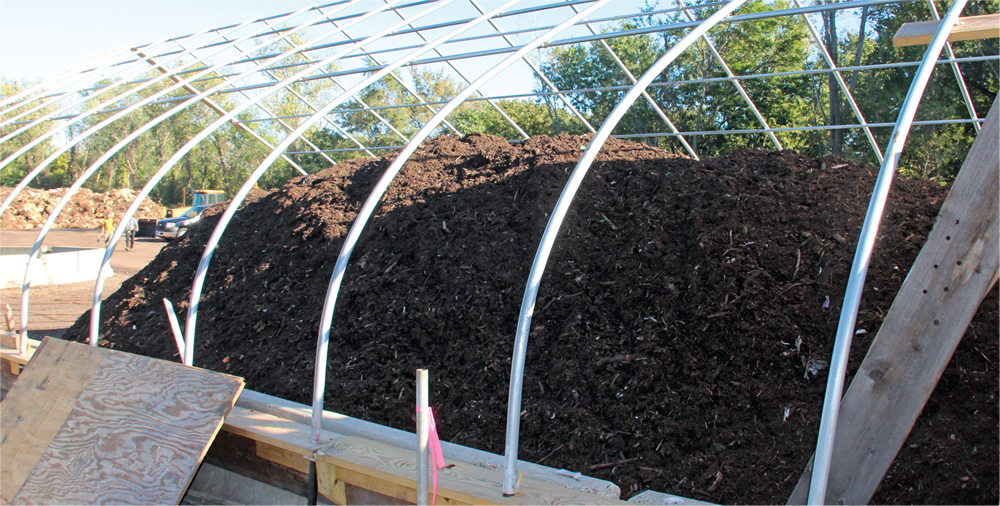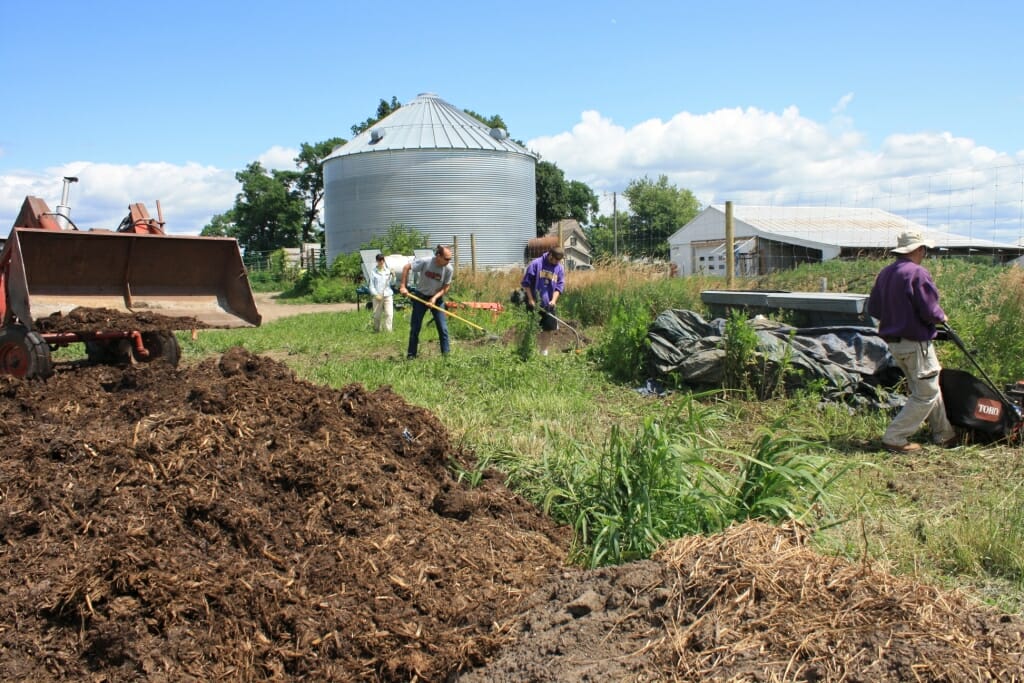Heating your greenhouse with compost is a smart and eco-friendly solution. Compost naturally generates heat as it breaks down organic materials. To utilize this heat for your greenhouse, set up a compost heating system using materials like straw, wood chips, and organic waste. Choose the right compost mix with a good balance of green and brown materials.
Moreover, regularly monitor the temperature and adjust as needed. This method not only provides cost-effective warmth for your plants but also extends the growing season. It’s a sustainable approach, reducing energy costs and promoting eco-friendly gardening practices.
How Compost Generates Heat Through The Decomposition Process?

Compost generates heat through the natural process of decomposition. When organic materials such as kitchen scraps, yard waste, and other plant-based matter are combined in a compost pile, microorganisms break down these materials.
As they feed on the organic matter, microorganisms release energy in the form of heat as a byproduct of their metabolic processes. This heat is a result of microbial activity accelerating the breakdown of complex organic compounds into simpler substances.
The temperature in a compost pile can rise significantly during this decomposition phase, creating a warm environment.
In reality, composting has the potential to reach temperatures between 130° to 170° F, effectively eliminating harmful bacteria and weeds.
Harnessing this heat is a sustainable way to provide warmth for a greenhouse, supporting plant growth in a controlled and eco-friendly manner.
What Are the Benefits of Heating Greenhouse With Compost?
Heating a greenhouse with compost is like giving plants a cozy and natural warmth from decomposing organic materials. It’s good for the environment, helps plants grow better, and saves money because it uses nature’s heat instead of relying on expensive energy sources.
Environmental Friendliness
Using Waste Wisely: Compost comes from things like food scraps and yard waste breaking down naturally. This process produces heat, and when we use this heat in a greenhouse, we’re making good use of waste, helping the environment.
Less Pollution: Compost heating is better for the environment because it doesn’t use as much energy from things like coal or gas. This helps reduce pollution and makes the air cleaner.
Better for Plants and Longer Growing Time
Cozy for Plants: Compost heating makes the greenhouse warm and comfy for plants. This means we can grow more types of plants all year round, even when it’s normally too cold outside.
More Veggies and Fruits: With compost heating, plants grow faster and give us more fruits and veggies. This is good for farmers because they can sell more and it’s good for us because we get more tasty food.
Saves Money and Easy to Use
Saves Energy and Money: Compost heating is like getting free warmth from nature. It doesn’t cost a lot of money to use once the system is set up. This helps farmers save money on energy bills.
Not Complicated: Using compost for heating is not hard. Once the system is ready, it keeps working without needing a lot of extra money or effort. It’s a simple and smart way to keep the greenhouse warm.
Helps Nature and Uses Less Stuff
Kind to the Earth: Compost heating is good for the planet because it makes less pollution. It’s like giving nature a helping hand by using less of the things that can harm the environment.
No Wasting Resources: By using compost, we are not using up things like coal or gas, which are not good for the earth. It’s a way of being careful with the resources we have and making sure we don’t waste them.
How to Use Compost as a Heat Source in Greenhouses?
To use compost for greenhouse heat, gather kitchen scraps and leaves in a bin, layer them, and check the temperature. Add pipes connected to a fan to circulate the warmth, making it a natural and budget-friendly way to keep your plants cozy.
List of Materials Needed for Compost Heating in a Greenhouse
- Compostable Materials: Collect organic materials like kitchen scraps, yard waste, and plant debris. A good mix of “green” materials (nitrogen-rich, like kitchen scraps) and “brown” materials (carbon-rich, like dry leaves) is essential for effective composting.
- Compost Bin or Pile: Choose a suitable composting container or designate an area for a compost pile. Options include compost bins, tumblers, or open-air piles. Bins with aeration features facilitate the decomposition process.
- Thermometer: A compost thermometer helps monitor the internal temperature of the compost pile. This is crucial for ensuring that the compost reaches and maintains temperatures necessary for effective heating.
- Pipes or Tubing: Pipes or tubing are used to circulate air through the compost pile, capturing the generated heat. The material should be durable and heat-resistant.
- Fan or Blower: A fan or blower aids in air circulation, helping to distribute the heat produced by the compost evenly throughout the greenhouse. This promotes a consistent and warm environment for plant growth.
Step-by-Step Guide on Setting up a Compost Heating System
Choose a Location
Select a suitable location for the compost pile or bin, considering factors like sunlight, accessibility, and airflow. Ensure the chosen spot allows for proper aeration.
Layer Compost Materials
Begin by layering green and brown compost materials in the chosen container or pile. Aim for a balanced mix to facilitate effective decomposition and heat generation.
Monitor Temperature
Regularly check the compost temperature using a thermometer. The ideal temperature for effective heating ranges between 130° to 170° F. Adjust the compost layers if necessary to maintain optimal conditions.
Install Air Circulation System
Insert pipes or tubing into the compost pile to create air channels. This allows air to circulate, capturing heat. Connect the tubing to a fan or blower positioned strategically to distribute the warmth within the greenhouse.
Monitor and Adjust
Continuously monitor the compost heating system. Adjust the airflow, compost layers, and other factors as needed to maintain consistent temperatures. This ensures a steady and reliable heat source for the greenhouse.
Prioritize Safety
Implement safety precautions, such as monitoring for fire hazards and keeping the compost pile away from flammable materials. Have firefighting equipment on hand to address potential safety concerns.
How Much Compost Do You Need To Heat A Greenhouse?
Usually, it’s a good idea to use 1 cubic yard of compost for every 23 square feet of greenhouse space to make it about 10-20 degrees warmer.
For example, a small greenhouse of 100 square feet needs around 4.3 cubic yards of compost. If you want it even warmer, you might need more compost or a special kind, like horse manure or mushroom compost.
However, the table below gives you an idea of how much compost you might need for different sizes of greenhouses
| Greenhouse Size | Compost Pile Size |
| 100 sq ft | 4.3 cubic yards |
| 200 sq ft | 8.7 cubic yards |
| 300 sq ft | 13 cubic yards |
| 400 sq ft | 17.4 cubic yards |
| 500 sq ft | 21.7 cubic yards |
How do I make a hot compost pile?

You can make a hot compost pile involves a careful balance of green and brown materials, proper layering, and ensuring proper aeration. Here’s a step-by-step guide to help you make a hot compost pile
Gather Materials
Green Materials (Nitrogen-Rich)
- Kitchen scraps (fruit and vegetable peelings, coffee grounds)
- Fresh yard waste (grass clippings)
- Manure from herbivores (cow, horse, chicken)
Brown Materials (Carbon-Rich)
- Dry leaves
- Straw or hay
- Shredded newspaper or cardboard
Choose a Location
Pick a suitable spot for your compost pile. Ideally, it should be on bare soil to allow for beneficial organisms to enter the pile. Ensure good drainage to prevent waterlogging.
Build the Base Layer
Create a base layer with coarse materials like small branches or straw. This helps with aeration at the bottom of the pile.
Alternate Green and Brown Layers
Layer green and brown materials alternately. Aim for a good mix to provide a balanced carbon-to-nitrogen ratio, promoting efficient decomposition.
Moisture Management
Keep the compost pile moist but not waterlogged. The materials should feel like a wrung-out sponge. Add water if the pile becomes too dry, or add more dry brown materials if it’s too wet.
Aerate the Pile
Turn the compost regularly to introduce oxygen. This aerates the pile and encourages the growth of aerobic bacteria, which thrive in the presence of oxygen and generate heat.
Monitor Temperature
Use a compost thermometer to monitor the internal temperature. Hot composting aims for temperatures between 130° to 170° F. This range promotes the activity of thermophilic bacteria that accelerate decomposition.
Maintain the Pile
Continue adding green and brown materials as they become available. Turning the pile every few days helps distribute heat and accelerate the composting process.
Patience and Observation
Hot composting typically takes a few weeks to a few months. Be patient, and observe the compost pile for changes in temperature, texture, and the disappearance of materials.
Harvesting the Compost
Once the composting process is complete, and the pile cools down, the compost is ready for use. It should have a crumbly texture, a dark color, and a rich, earthy smell.
FAQ
How long does compost generate heat?
Compost can generate heat for several weeks to months, depending on factors like size, composition, and management. The initial intense heat phase can last a few days to a couple of weeks.
Can you heat a greenhouse with manure?
Yes, manure is an effective source of heat in compost and can be used to warm a greenhouse. The decomposition process in the compost generates heat.
What is the best compost for greenhouses?
Well-balanced compost with a mix of green and brown materials is ideal for greenhouses. Materials like kitchen scraps, leaves, and yard waste create a nutrient-rich compost.
What happens if compost gets too hot?
If compost gets too hot it can lead to the loss of beneficial microorganisms and may result in nutrient imbalances. It’s essential to monitor and manage compost temperature to maintain optimal conditions.
Does hot compost need sun?
No, sunlight is not a strict requirement for the compost to generate heat. While sunlight can contribute to the overall warmth of a compost pile, hot composting primarily relies on microbial activity during decomposition.
Is compost flammable?
No, compost is generally not flammable under normal conditions. However, if the compost pile is exceptionally dry, there may be a risk of combustion. Proper moisture and proper management mitigate this risk.
Does hot compost need oxygen?
Yes, oxygen is needed for the aerobic microbial activity that generates heat in hot compost. Turning the compost regularly ensures aeration, supporting the decomposition process.
Final words
To sum up, heating a greenhouse with compost is a clever and Earth-friendly approach. It supports plant growth, saves money, and benefits the environment. Creating a warm space for plants using compost not only nurtures our gardens but also plays a part in keeping our planet healthy.

